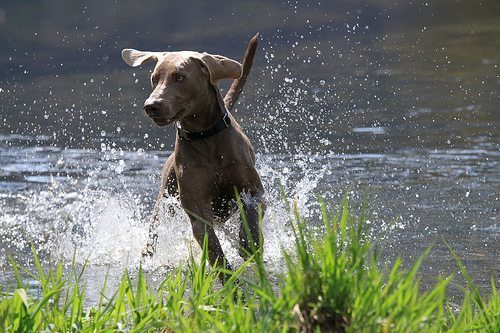The Weimaraner History

The Weimaraner originated in Germany and is a relatively new breed. These canines were bred by royalty for hunting large game such as boar, bear and deer. As the popularity of large game hunting diminished, Weimaraners were used for hunting smaller game like fowl, rabbits and foxes. Some may recognize the breed from Sesame Street, as they have been featured in several skits dressed up in clothing. The Weimaraner was first recognized by the AKC in 1943. Their talents include hunting, tracking, retrieving, pointing, watchdog, guarding, police work, service dogs for the disabled, search & rescue and agility.
Breed Description
The Weimaraner is a large, athletic, working dog. They have a medium sized head. The nose is gray. The wide-set eyes are light amber, gray, or blue-gray. Ears are high-set and are long and hang forward along the sides of the head. The front legs are straight with webbed, compact feet. The coat is short and smooth and is tight to the entire body. Their coat can come in shades of mouse-gray to silver-gray, tending towards darker shades on the body and lighter shades on the head and ears. Occasionally there will be white markings on the chest. The Weimaraner stands from 24 to 27 inches tall and weighs between 55 and 70 pounds. This breed does not have an undercoat, so extreme cold should be avoided. Although the coat is short, Weimaraners still shed. These canines can also be found with a longer coat. The coat is silky and the tail is feathered. While most kennel clubs recognize the long-haired variety, the American Kennel Club does not. Their lifespan is 10 to 14 years.
Personality & Care
Ideal companions for the Weimaraner would be singles, active, sporty types, families with older children and hunters and hikers. They are happy, loving, intelligent and affectionate. They can become rambunctious and difficult to control if they do not get enough exercise. Their training needs to begin in puppyhood, and followed diligently. As a hunting dog, Weimaraners have a strong prey instinct, and should not be trusted with small non-canine animals such as hamsters, guinea pigs, and rabbits. Because they are protective and loyal, they make good guard and watch dogs. They need to know what is expected of them, as they only want to please. They will do well in an apartment as long as they get sufficient exercise daily. They do best with a large yard in which to run. Keep them active and you’ll have a happy Wiemaraner.
Photo: Courtesy of sarpi94 via Flickr (CC BY-ND 2.0)









